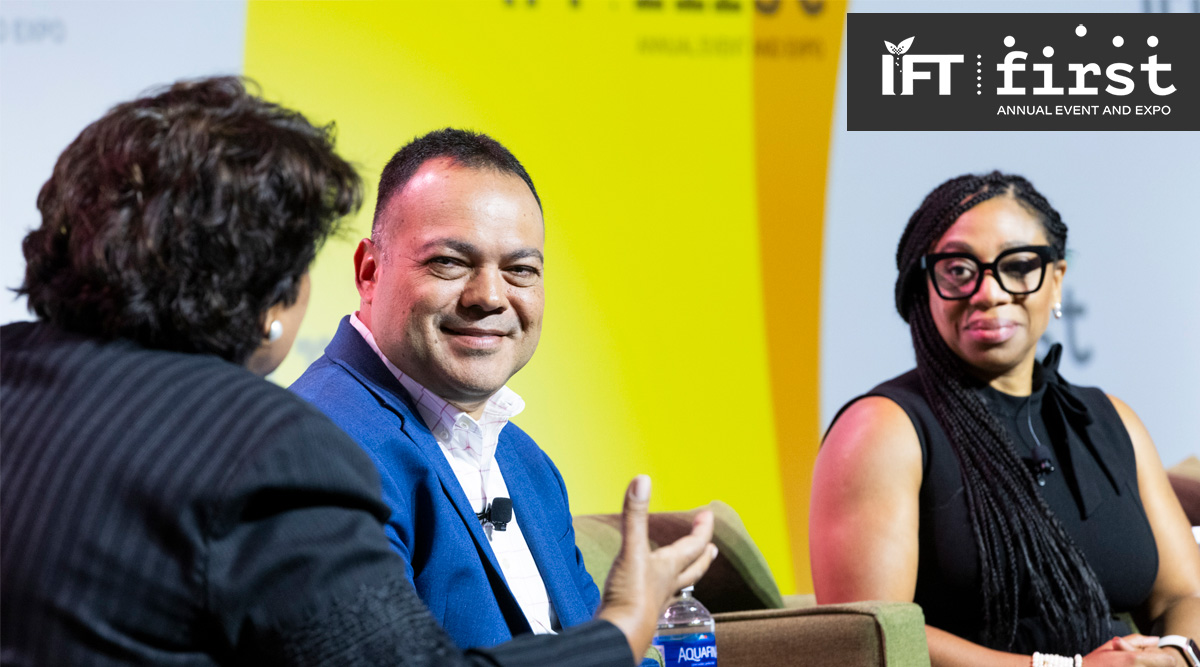Think Ahead About Food Safety—Or Be Left Behind
Experts share tips for anticipating and avoiding food safety threats.
From ransomware shutdowns of meatpacking plants to fraudulent attempts to sell fake organic grains to a global pandemic that scrambled the supply chain, food scientists and the companies for which they work need to be able to anticipate food safety risks and have plans in place to mitigate them, according to panelists at a featured session at IFT FIRST on Tuesday, titled “Expect the Unexpected: Failure to Anticipate Threats Is a Critical Food Safety Risk.”
“Events are coming at you from a lot of different angles. The test is, how well is your organization learning?” said Jeff Varcoe, PhD, vice president, quality assurance & food safety at J.M. Smucker Co. “You used to say, ‘That can’t be. That’ll never happen.’ Guess what, it does. If it hasn’t, it will. You have to identify critical risks and be creative in how you approach them.”
Doing so requires constant networking, ranging from physical trade shows like IFT FIRST to digitized plant floors and supply webs, Varcoe said. “Some components coming into food products may be touched a half-dozen times before they get to your dock,” he said. “How do you know it was stored frozen? How do you know it was in a secured trailer? How do you know someone didn’t knowingly tamper with it? … How does AI tie into this? We’re data-rich in most cases, but it’s data, and sometimes it isn’t easy to access, let alone do trending [analyses].”
A plethora of databases about incidents of food adulteration can help you think about your potential vulnerabilities and put a mitigation plan in place, said Rolando Gonzalez, PhD, chief science officer at The Acheson Group. “What are we going to do about it? How are we going to be proactive? And then let’s not forget the training of people,” he said. “Choose a known contaminant, go through simulation, and be proactive. You learn a lot from that. Set your mentality as if you were one of those perpetrators. Then take action.”
Companies need to think through their crisis management systems and be able to know how they would proceed under various scenarios, said Trish Tolbert, North America director of food safety and sanitation at McCain Foods. “How quickly do certain people need to be notified? Who is the ultimate decision maker?” she said. Who should handle the media—and regulators?
When sourcing ingredients, Tolbert counseled researching their origins and the backstory of the supplier with which your company plans to work. “Which ones are high-risk?” she said. “Do you know the supplier well? Is it difficult to get information from them? Have they had incidents in the past? … Also, do you need 12 strawberry flavors? That increases your complexity” and thus range of vulnerability.
Companies need to move from a reactive to a proactive mindset, in much the same way they did when the Food Safety and Modernization Act passed in 2011, realizing that in addition to committing food fraud for financial gain, there are bad actors that intentionally poison food, said Jennifer van de Ligt, PhD, senior consultant at ToxStrategies. “People would do that? Yes, people do that,” she said. Combating such risks requires “understanding those areas that are critical in your facility, where you have the biggest risk for potential adulterants to be added in your system.”
Another avenue where food safety can become compromised is through cyber warfare, which is sometimes perpetrated by nation-states, van de Ligt said. “Just like in [physical] food safety, you wash hands and have good safety hygiene, I encourage all of you to go home and learn about cyber hygiene,” she said. When information technology staff remind you to change your passwords, listen to them rather than becoming cranky about it. And be aware that ransomware attacks usually come through phishing e-mails. “As scientists, be skeptical,” van de Ligt said. “If you see something that doesn’t look right, don’t click on that button.”
Food Technology Articles

Battling Biofilms
In this column, the author describes the stages of biofilm development in food processing plants, methods of removal, and best practices for prevention.

Smart Steps to Peak Traceability
Creating an effective road map to advance your food traceability program is key to overcoming data, process, and stakeholder challenges.

Ensuring Quality and Safety in Fried Foods
In this column, the author describes basic principles for maintaining frying oil quality and safety.

Best Practices for Chemical Hazards
This column offers expert tips on best practices to help mitigate food chemical hazard risks that have made recent headlines, including PFAS, BVO, and heavy metals.

Foodborne Pathogens: The Unusual Suspects
In this article, readers will learn about some of the less common foodborne pathogens.
Recent Brain Food

IFT Science and Policy Team Forecasts Six Trends for 2023
From a processed foods comeback to breaking food system silos and addressing food and nutrition security, our science and policy experts identify top science of food trends.
IFT Responds to FDA's Food Traceability Rule
The new regulations harness traceability data to reduce foodborne illness in the supply chain.
Packing a School Lunch? Keep Safety Top of Mind
A few simple steps are all it takes to keep school lunches not only tasty but safe, says IFT’s food safety expert Sara Bratager.
10 Common Culprits of Foodborne Illnesses
As a food consumer, there are many methods to reduce the risk of foodborne illness.

Nine Tips to Keep Food Safe This Fall
Labor Day weekend generally marks the unofficial end of summer in the United States, but it doesn’t have to mean the end of summer fun.


